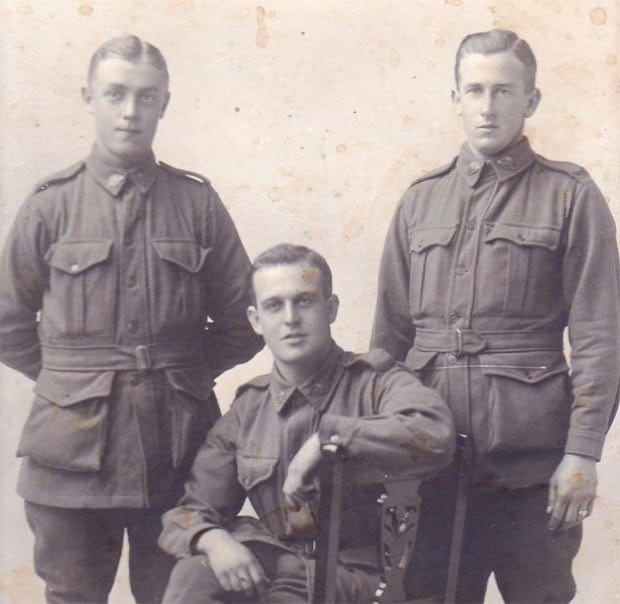This is the Carlton team, gathering for an historic photograph by the pickets at the old East Melbourne Cricket Ground on the King’s Birthday long weekend of 100 years past - Monday, June 8, 1914.
The image, in which a moustachioed member of the Victorian constabulary also proudly poses, was taken just prior to the Round 8 match with Essendon – the first of 12 victories in succession through the first of Carlton’s back-to-back Premiership seasons of ’14/’15.
Appearing in the photo are three players whose images were not previously in the club’s possession – Jack Lowe (a member of Carlton’s 1914 Grand Final triumph having represented Collingwood the previous year), Stan McKenzie and the dual Premiership player Athol Sharp.
Lowe and McKenzie stand side by side, fifth and sixth from the left in the back row, while Sharp sits with his legs crossed second from the right in the front.
The photograph was forwarded to the club by Rod McPherson, a Perth-based financier, who found it amongst football mementoes of his late father-in-law Bill Taggart.
“Bill was born in 1929 and passed away last November, and strangely enough his wife of 61 years, Enid, passed away that same day some 12 hours before,” McPherson said.
“My family is trying to piece together the link between Bill and this Carlton side. He talked fondly (and regularly) of his football days but we are unable to recall him speaking of a family member or close friend playing for Carlton. He played for Footscray colts and reserves, as well as Coburg Amateurs, representing Victoria in the national carnival. He later moved to Perth where he played for Subiaco and East Fremantle (winning the 1954 Prendergast Medal) before retiring and coaching East Fremantle 3rds.
“We are curious about the photo’s origins as it was among Bill’s footy ‘scrapbook’ stuff. We think that one of the Carlton players may be a relative but we are not sure which one.
McPherson contacted Carlton after recognising that the logo sported by the players on the front of their guernseys correlated with that appearing on the heritage guernseys worn by today’s Blueboys. He also asked if the players in this photograph could be identified.
The club was able to determine that as Tom Clancy, who stands at the far right in the team photo, made his 74th and final appearance for the Blues in Round 9, 1914, the team must have taken to the field in one of the first nine matches. White shorts then narrowed the options to the Carlton away games of rounds 1, 3, 4, 7 and 8, but Jack Wells (who featured for Carlton in rounds, 1, 3 and 4 at Victoria Park, the MCG and the Lake Oval respectively) does not appear in this photo, nor does George Topping (who was there for the Blues in Round 7 at Corio Oval).
Thirteen players featured in this image – Alf Baud, Ted Brown, Bill Cook, Percy Daykin, Billy Dick, Gordon Green, “Champagne” Charlie Hammond, Harry Haughton, Ernie Jamieson, Steve Leehane, Jack Lowe, Andy McDonald and the club’s first 200-game player Rod “Wee” McGregor – represented Carlton in its 1914 Grand Final victory over South Melbourne, with captain Dick best afield.
Baud, Brown, Daykin, Gardiner, Green, Hammond (Carlton’s only five-time Premiership player), Haughton Jamieson, McDonald, McGregor and Sharp backed it up in the 1915 Grand Final won to Collingwood’s chagrin, and Challis was also there, sharing best afield honours with McDonald.
The Tasmanians McKenzie and Challis (to whom Levi Casboult is distantly related) would both lose their lives in the First World War.
Challis, considered best afield in the Blues’ 1915 Grand Final triumph, was killed by shellfire in Armentières on June 16 the following year. McKenzie, cruelly omitted after an indifferent 1914 Preliminary, later served his King and Country as a medical orderly who tended to the casualties on the Gallipoli Peninsula – only to be transferred to Alexandria, Egypt, where he died of an acute attack of appendicitis aboard the HMAT Kyarra on December 8, 1915.
McKenzie’s passing, reported in The Examniner, Launceston, on Christmas Eve of that year appeared as follows;
“SERGEANT ‘STAN’ McKENZIE DEAD.
General regret will be occasioned by the news received yesterday of the death from appendicitis of Sergeant M. S. McKenzie, son of Mr. Harry McKenzie, Warden of the Launceston Marine Board. The sad intelligence was conveyed to the parents by Canon de Coetlogon, who expressed the deepest regret and sympathy of their Majesties the King and Queen, and the Commonwealth Government, as well as the District Commandant, in the loss sustained by them and the army. The late Sergeant McKenzie went from Australia with the First Clearing Hospital and after a brief sojourn in England with his unit, had been several months at the Dardanelles, where the hospital was established immediately after the historic landing on April 25. His death removes a man who was amongst Tasmania’s finest athletes, as a footballer he often played for Northern Tasmania, and represented the state in the big Australasian carnival, held at Adelaide some years ago. He was regarded as the most brilliant centre man of recent years, and played for a number of years with the Launceston club, from which he transferred to the Victorian League team, Carlton. His cricket prowess was equally fine, for he made many runs for Northern Tasmania, and attained to very considerable success as a bowler. The late Sergeant McKenzie, who was a bank clerk prior to enlistment, was well known in the athletic field throughout Tasmania. A younger brother, Sapper G. F. McKenzie, was awarded the D.C.M. for conspicuous gallantry in rescuing a comrade under fire.”
When the Carlton players took to the field for the 1916 Preliminary Final against Fitzroy, Athol Sharp wore a black armband for Challis. The match would not go well for Sharp, who suffered a broken collarbone in the process.

While still endeavouring to overcome the injury, Sharp put his football career on hold to enlist for active service in October 1916. He is pictured here standing at right with close mates JC Vallance and EW Oliver (with whom he enlisted on the same day), in a photo carrying the inscription, “With best love from the Boys”.
At the tender age of 20, Sharp was assigned to the artillery, and in May 1917 set sail for France.
A detailed report on The Blueseum website records that Sharp’s 14th Field Artillery Brigade provided invaluable support to the Australian infantry, in campaigns that finally turned the tide in favour of the Allied cause. When the Armistice was signed on November 11, 1918, five years of the bloodiest conflict in human history was ended at last.
Sharp returned to Australia in July, 1919 and was soon back at Princes Park, playing cricket over the marvellous, peaceful summer of 1919, and saddling up to play football again for the Blues the following year. He managed seven senior appearances on top of his previous 49-game stint, but for reasons unclear hung ’em up following a contest at the Brunswick Street Oval on the afternoon of July 17, 1920.
For the remainder of his long sporting life, Sharp was a keen supporter of the Old Dark Navy Blues, and a stalwart of the Carlton Cricket Club. During the 1960s, under the Presidency of another former Blue in Frank Triplett, Sharp was a familiar figure as a doorman at Carlton Cricket Club – a task he happily carried out until his death in 1969.
And so the story of the Carlton team of Round 8, 1914, is complete. Only the mystery of Bill Taggart’s links with that precious photograph remains.
Players featured in this Carlton senior XVIII team photograph of Round 8, 1914 are as follows;
Standing l to r: Ernie Jamieson, George Challis, Steve Leehane, Alf Baud, Jack Lowe, Stan McKenzie, Tom Clancy
Middle row: Vin Gardiner, Bill Cook, Harry Haughton (vice-capt.), Billy Dick (capt.), Charlie Hammond, Percy Daykin, Rod McGregor
Front: Andy McDonald, Ted Brown, Athol Sharp, Gordon Green


